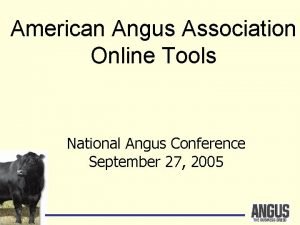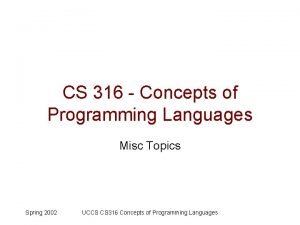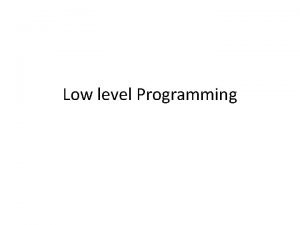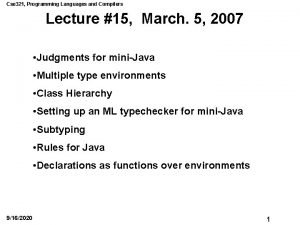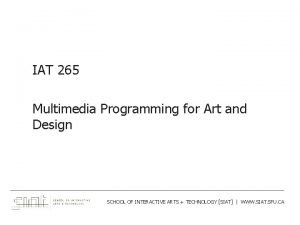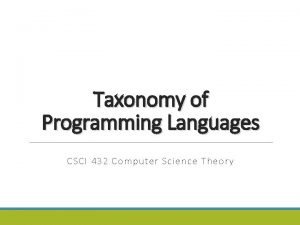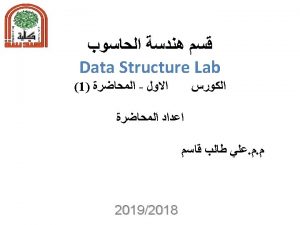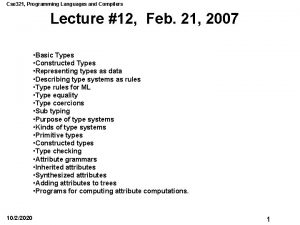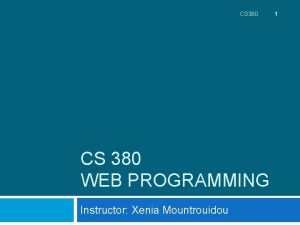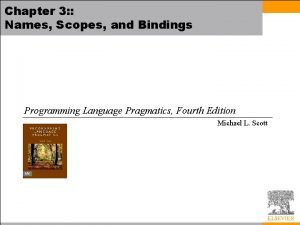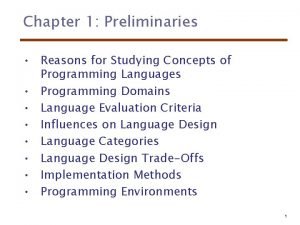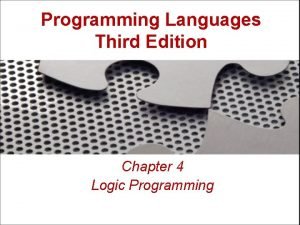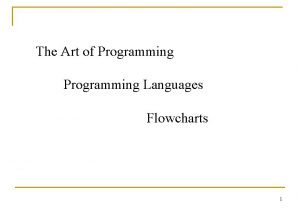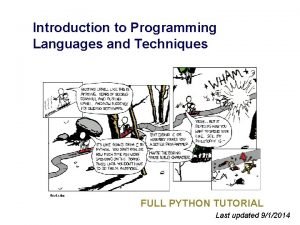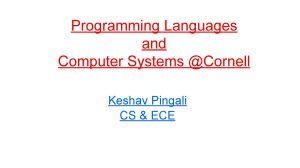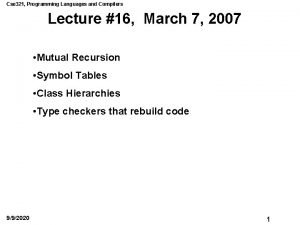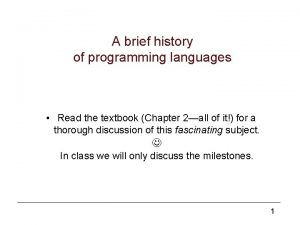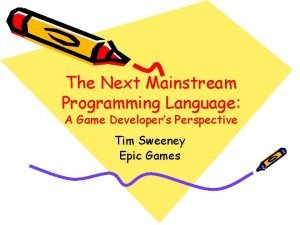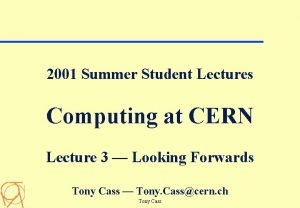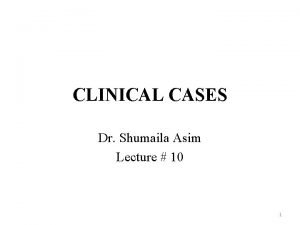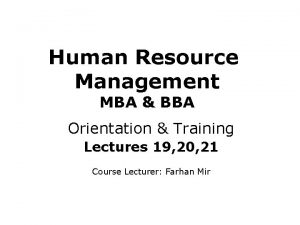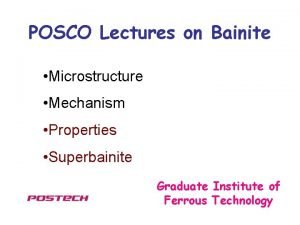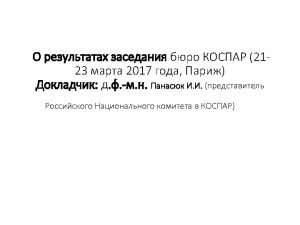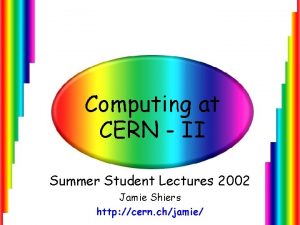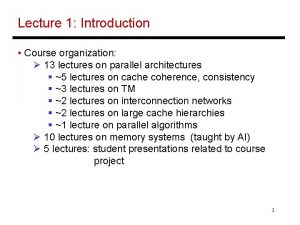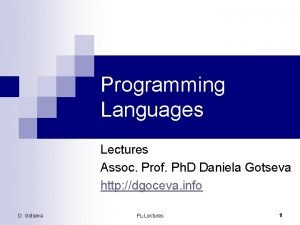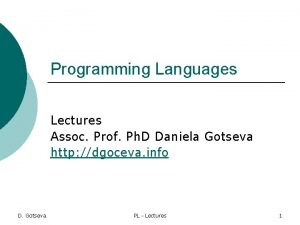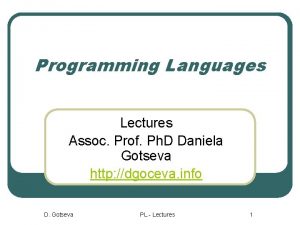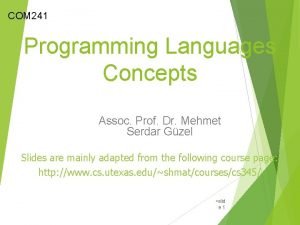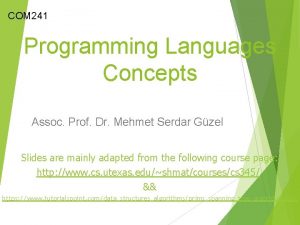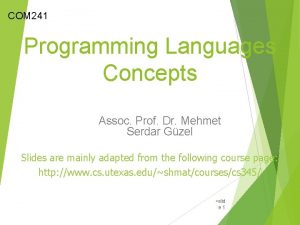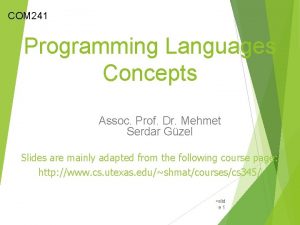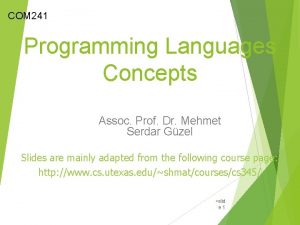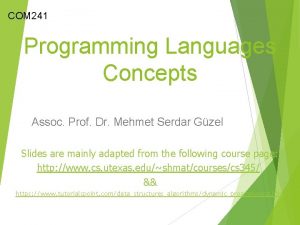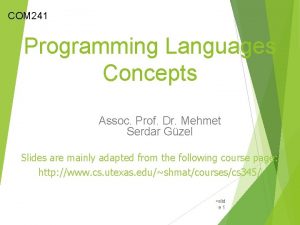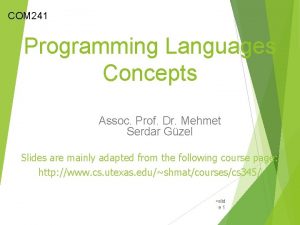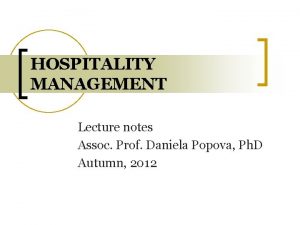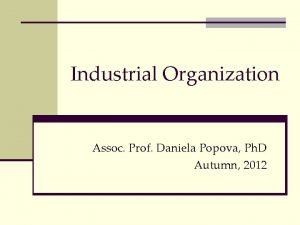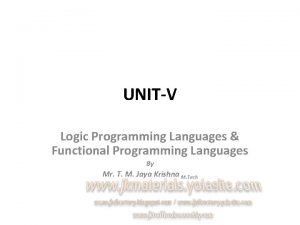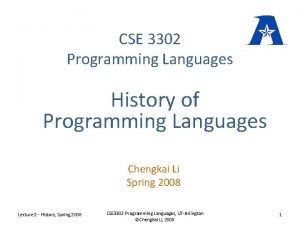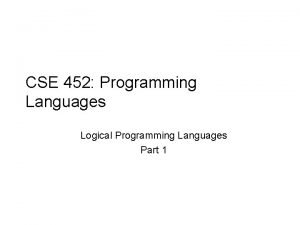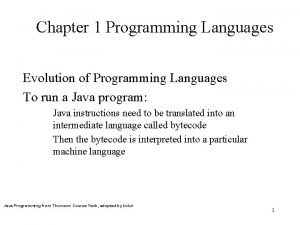Programming Languages Lectures Assoc Prof Ph D Daniela







































































- Slides: 71

Programming Languages Lectures Assoc. Prof. Ph. D Daniela Gotseva http: //dgoceva. info D. Gotseva PL-Lectures 1

Input and Output Part I Lecture No 12 D. Gotseva PL-Lectures 2

Input/Output l l Input and output are not part of the C language itself, so we have not emphasized them in our presentation thus far. Nonetheless, programs interact with their environment in much more complicated ways than those we have shown before. We will describe the standard library, a set of functions that provide input and output, string handling, storage management, mathematical routines, and a variety of other services for C programs. We will concentrate on input and output. D. Gotseva PL-Lectures 3

Input/Output l l The ANSI standard defines these library functions precisely, so that they can exist in compatible form on any system where C exists. Programs that confine their system interactions to facilities provided by the standard library can be moved from one system to another without change. The properties of library functions are specified in more than a dozen headers; we have already seen several of these, including <stdio. h>, <string. h>, and <ctype. h>. We will ot present the entire library here, since we are more interested in writing C programs that use it. D. Gotseva PL-Lectures 4

Standard Input and Output The library implements a simple model of text input and output. A text stream consists of a sequence of lines; each line ends with a newline character. If the system doesn't operate that way, the library does whatever necessary to make it appear as if it does. For instance, the library might convert carriage return and linefeed to newline on input and back again on output. l The simplest input mechanism is to read one character at a time from the standard input, normally the keyboard, with getchar: int getchar(void) l D. Gotseva PL-Lectures 5

Standard Input and Output l l getchar returns the next input character each time it is called, or EOF when it encounters end of file. The symbolic constant EOF is defined in <stdio. h>. The value is typically -1, bus tests should be written in terms of EOF so as to be independent of the specific value. D. Gotseva PL-Lectures 6

Standard Input and Output In many environments, a file may be substituted for the keyboard by using the < convention for input redirection: if a program prog uses getchar, then the command line prog <infile l causes prog to read characters from infile instead. The switching of the input is done in such a way that prog itself is oblivious to the change; in particular, the string “<infile'' is not included in the commandline arguments in argv. l D. Gotseva PL-Lectures 7

Standard Input and Output The function int putchar(int) l is used for output: putchar(c) puts the character c on the standard output, which is by default the screen. putchar returns the character written, or EOF is an error occurs. Again, output can usually be directed to a file with >filename: if prog uses putchar, prog >outfile l will write the standard output to outfile instead. l D. Gotseva PL-Lectures 8

Standard Input and Output produced by printf also finds its way to the standard output. Calls to putchar and printf may be interleaved - output happens in the order in which the calls are made. l Each source file that refers to an input/output library function must contain the line #include <stdio. h> l before the first reference. When the name is bracketed by < and > a search is made for the header in a standard set of places. l D. Gotseva PL-Lectures 9

Standard Input and Output l Many programs read only one input stream and write only one output stream; for such programs, input and output with getchar, putchar, and printf may be entirely adequate, and is certainly enough to get started. This is particularly true if redirection is used to connect the output of one program to the input of the next. For example, consider the program lower, which converts input to lower case: D. Gotseva PL-Lectures 10

Standard Input and Output l l l The function tolower is defined in <ctype. h>; it converts an upper case letter to lower case, and returns other characters untouched. As we mentioned earlier, “functions'' like getchar and putchar in <stdio. h> and tolower in <ctype. h> are often macros, thus avoiding the overhead of a function call per character. Regardless of how the <ctype. h> functions are implemented on a given machine, programs that use them are shielded from knowledge of the character set. D. Gotseva PL-Lectures 11

Formatted Output - printf The output function printf translates internal values to characters. int printf(char *format, arg 1, arg 2, . . . ); l printf converts, formats, and prints its arguments on the standard output under control of the format. It returns the number of characters printed. l The format string contains two types of objects: ordinary characters, which are copied to the output stream, and conversion specifications, each of which causes conversion and printing of the next successive argument to printf. l D. Gotseva PL-Lectures 12

Formatted Output - printf l Each conversion specification begins with a % and ends with a conversion character. Between the % and the conversion character there may be, in order: l l l D. Gotseva A minus sign, which specifies left adjustment of the converted argument. A number that specifies the minimum field width. The converted argument will be printed in a field at least this wide. If necessary it will be padded on the left (or right, if left adjustment is called for) to make up the field width. A period, which separates the field width from the precision. A number, the precision, that specifies the maximum number of characters to be printed from a string, or the number of digits after the decimal point of a floating-point value, or the minimum number of digits for an integer. An h if the integer is to be printed as a short, or l (letter ell) if as a long. PL-Lectures 13

Basic Printf Conversions D. Gotseva PL-Lectures 14

Formatted Output - printf A width or precision may be specified as *, in which case the value is computed by converting the next argument (which must be an int). For example, to print at most max characters from a string s, printf("%. *s", max, s); l D. Gotseva PL-Lectures 15

Formatted Output - printf l Most of the format conversions have been illustrated in earlier chapters. One exception is the precision as it relates to strings. The following table shows the effect of a variety of specifications in printing “hello, world'' (12 characters). We have put colons around each field so you can see it extent. D. Gotseva PL-Lectures 16

Formatted Output - printf A warning: printf uses its first argument to decide how many arguments follow and what their type is. It will get confused, and you will get wrong answers, if there are not enough arguments of if they are the wrong type. You should also be aware of the difference between these two calls: printf(s); /* FAILS if s contains % */ printf("%s", s); /* SAFE */ l D. Gotseva PL-Lectures 17

Formatted Output - printf The function sprintf does the same conversions as printf does, but stores the output in a string: int sprintf(char *string, char *format, arg 1, arg 2, . . . ); l sprintf formats the arguments in arg 1, arg 2, etc. , according to format as before, but places the result in string instead of the standard output; string must be big enough to receive the result. l D. Gotseva PL-Lectures 18

Variable-length Argument Lists This section contains an implementation of a minimal version of printf, to show to write a function that processes a variable-length argument list in a portable way. Since we are mainly interested in the argument processing, minprintf will process the format string and arguments but will call the real printf to do the format conversions. l The proper declaration for printf is int printf(char *fmt, . . . ) l D. Gotseva PL-Lectures 19

Variable-length Argument Lists The declaration. . . means that the number and types of these arguments may vary. It can only appear at the end of an argument list. Our minprintf is declared as void minprintf(char *fmt, . . . ) l since we will not return the character count that printf does. l The tricky bit is how minprintf walks along the argument list when the list doesn't even have a name. The standard header <stdarg. h> contains a set of macro definitions that define how to step through an argument list. The implementation of this header will vary from machine to machine, but the interface it presents is uniform. l D. Gotseva PL-Lectures 20

Variable-length Argument Lists l l The type va_list is used to declare a variable that will refer to each argument in turn; in minprintf, this variable is called ap, for “argument pointer. '' The macro va_start initializes ap to point to the first unnamed argument. It must be called once before ap is used. There must be at least one named argument; the final named argument is used by va_start to get started. D. Gotseva PL-Lectures 21

Variable-length Argument Lists l l Each call of va_arg returns one argument and steps ap to the next; va_arg uses a type name to determine what type to return and how big a step to take. Finally, va_end does whatever cleanup is necessary. It must be called before the program returns. D. Gotseva PL-Lectures 22

D. Gotseva PL-Lectures 23

Formatted Input - Scanf The function scanf is the input analog of printf, providing many of the same conversion facilities in the opposite direction. int scanf(char *format, . . . ) l scanf reads characters from the standard input, interprets them according to the specification in format, and stores the results through the remaining arguments. l The other arguments, each of which must be a pointer, indicate where the corresponding converted input should be stored. As with printf, this section is a summary of the most useful features, not an exhaustive list. l D. Gotseva PL-Lectures 24

Formatted Input - Scanf l l scanf stops when it exhausts its format string, or when some input fails to match the control specification. It returns as its value the number of successfully matched and assigned input items. This can be used to decide how many items were found. On the end of file, EOF is returned; note that this is different from 0, which means that the next input character does not match the first specification in the format string. D. Gotseva PL-Lectures 25

Formatted Input - Scanf l l The next call to scanf resumes searching immediately after the last character already converted. There is also a function sscanf that reads from a string instead of the standard input: int sscanf (char *string, char *format, arg 1 arg 2, . . . ) l It scans the string according to the format in format and stores the resulting values through arg 1, arg 2, etc. These arguments must be pointers. D. Gotseva PL-Lectures 26

Formatted Input - Scanf l The format string usually contains conversion specifications, which are used to control conversion of input. The format string may contain: l l l D. Gotseva Blanks or tabs, which are not ignored. Ordinary characters (not %), which are expected to match the next non-white space character of the input stream. Conversion specifications, consisting of the character %, an optional assignment suppression character *, an optional number specifying a maximum field width, an optional h, l or L indicating the width of the target, and a conversion character. PL-Lectures 27

Formatted Input - Scanf l l A conversion specification directs the conversion of the next input field. Normally the result is places in the variable pointed to by the corresponding argument. If assignment suppression is indicated by the * character, however, the input field is skipped; no assignment is made. An input field is defined as a string of non-white space characters; it extends either to the next white space character or until the field width, is specified, is exhausted. D. Gotseva PL-Lectures 28

Formatted Input - Scanf l l l This implies that scanf will read across boundaries to find its input, since newlines are white space. (White space characters are blank, tab, newline, carriage return, vertical tab, and formfeed. ) The conversion character indicates the interpretation of the input field. The corresponding argument must be a pointer, as required by the call-by-value semantics of C. D. Gotseva PL-Lectures 29

Basic Scanf Conversions D. Gotseva PL-Lectures 30

Formatted Input - Scanf l The conversion characters d, i, o, u, and x may be preceded by h to indicate that a pointer to short rather than int appears in the argument list, or by l (letter ell) to indicate that a pointer to long appears in the argument list. D. Gotseva PL-Lectures 31

Formatted Input - Scanf l Example: Suppose we want to read input lines that contain dates of the form 25 Dec 1988 l The scanf statement is int day, year; char monthname[20]; scanf("%d %s %d", &day, monthname, &year); l No & is used with monthname, since an array name is a pointer. l D. Gotseva PL-Lectures 32

Formatted Input - Scanf Literal characters can appear in the scanf format string; they must match the same characters in the input. So we could read dates of the form mm/dd/yy with the scanf statement: int day, month, year; scanf("%d/%d/%d", &month, &day, &year); l scanf ignores blanks and tabs in its format string. l Furthermore, it skips over white space (blanks, tabs, newlines, etc. ) as it looks for input values. To read input whose format is not fixed, it is often best to read a line at a time, then pick it apart with sscanf. l D. Gotseva PL-Lectures 33

Formatted Input - Scanf l For example, suppose we want to read lines that might contain a date in either of the forms above. Then we could write D. Gotseva PL-Lectures 34

Formatted Input - Scanf Calls to scanf can be mixed with calls to other input functions. The next call to any input function will begin by reading the first character not read by scanf. l A final warning: the arguments to scanf and sscanf must be pointers. By far the most common error is writing scanf("%d", n); l instead of scanf("%d", &n); l This error is not generally detected at compile time. l D. Gotseva PL-Lectures 35

Input and Output Part II Lecture No 13 D. Gotseva PL-Lectures 36

File Access l l The examples so far have all read the standard input and written the standard output, which are automatically defined for a program by the local operating system. The next step is to write a program that accesses a file that is not already connected to the program. One program that illustrates the need for such operations is cat, which concatenates a set of named files into the standard output. cat is used for printing files on the screen, and as a generalpurpose input collector for programs that do not have the capability of accessing files by name. D. Gotseva PL-Lectures 37

File Access cat х. с у. с l prints the contents of the files x. c and y. c (and nothing else) on the standard output. l The question is how to arrange for the named files to be read that is, how to connect the external names that a user thinks of to the statements that read the data. l The rules are simple. Before it can be read or written, a file has to be opened by the library function fopen takes an external name like x. c or y. c, does some housekeeping and negotiation with the operating system (details of which needn't concern us), and returns a pointer to be used in subsequent reads or writes of the file. D. Gotseva PL-Lectures 38

File Access l This pointer, called the file pointer, points to a structure that contains information about the file, such as the location of a buffer, the current character position in the buffer, whether the file is being read or written, and whether errors or end of file have occurred. Users don't need to know the details, because the definitions obtained from <stdio. h> include a structure declaration called FILE. The only declaration needed for a file pointer is exemplified by D. Gotseva PL-Lectures 39

File Access This says that fp is a pointer to a FILE, and fopen returns a pointer to a FILE. Notice that FILE is a type name, like int, not a structure tag; it is defined with a typedef. The call to fopen in a program is fp = fopen(name, mode); l The first argument of fopen is a character string containing the name of the file. The second argument is the mode, also a character string, which indicates how one intends to use the file. l Allowable modes include read ("r"), write ("w"), and append ("a"). Some systems distinguish between text and binary files; for the latter, a "b" must be appended to the mode string. l D. Gotseva PL-Lectures 40

File Access l l If a file that does not exist is opened for writing or appending, it is created if possible. Opening an existing file for writing causes the old contents to be discarded, while opening for appending preserves them. Trying to read a file that does not exist is an error, and there may be other causes of error as well, like trying to read a file when you don't have permission. If there is any error, fopen will return NULL. D. Gotseva PL-Lectures 41

File Access The next thing needed is a way to read or write the file once it is open. getc returns the next character from a file; it needs the file pointer to tell it which file. int getc(FILE *fp) l getc returns the next character from the stream referred to by fp; it returns EOF for end of file or error. l putc is an output function: int putc(int c, FILE *fp) l putc writes the character c to the file fp and returns the character written, or EOF if an error occurs. Like getchar and putchar, getc and putc may be macros instead of functions. l D. Gotseva PL-Lectures 42

File Access l l l When a C program is started, the operating system environment is responsible for opening three files and providing pointers for them. These files are the standard input, the standard output, and the standard error; the corresponding file pointers are called stdin, stdout, and stderr, and are declared in <stdio. h>. Normally stdin is connected to the keyboard and stdout and stderr are connected to the screen, but stdin and stdout may be redirected to files D. Gotseva PL-Lectures 43

File Access getchar and putchar can be defined in terms of getc, putc, stdin, and stdout as follows: #define getchar() getc(stdin) #define putchar(c) putc((c), stdout) l For formatted input or output of files, the functions fscanf and fprintf may be used. These are identical to scanf and printf, except that the first argument is a file pointer that specifies the file to be read or written; the format string is the second argument int fscanf(FILE *fp, char *format, . . . ) int fprintf(FILE *fp, char *format, . . . ) l D. Gotseva PL-Lectures 44

File Access l l With these preliminaries out of the way, we are now in a position to write the program cat to concatenate files. The design is one that has been found convenient for many programs. If there are command-line arguments, they are interpreted as filenames, and processed in order. If there are no arguments, the standard input is processed. D. Gotseva PL-Lectures 45

D. Gotseva PL-Lectures 46

File Access The file pointers stdin and stdout are objects of type FILE *. They are constants, however, not variables, so it is not possible to assign to them. l The function int fclose(FILE *fp) l is the inverse of fopen, it breaks the connection between the file pointer and the external name that was established by fopen, freeing the file pointer for another file. l D. Gotseva PL-Lectures 47

File Access l l Since most operating systems have some limit on the number of files that a program may have open simultaneously, it's a good idea to free the file pointers when they are no longer needed, as we did in cat. There is also another reason for fclose on an output file - it flushes the buffer in which putc is collecting output. fclose is called automatically for each open file when a program terminates normally. (You can close stdin and stdout if they are not needed. They can also be reassigned by the library function freopen. ) D. Gotseva PL-Lectures 48

Error Handling - Stderr and Exit l l l The treatment of errors in cat is not ideal. The trouble is that if one of the files can't be accessed for some reason, the diagnostic is printed at the end of the concatenated output. That might be acceptable if the output is going to a screen, but not if it's going into a file or into another program via a pipeline. To handle this situation better, a second output stream, called stderr, is assigned to a program in the same way that stdin and stdout are. Output written on stderr normally appears on the screen even if the standard output is redirected. Let us revise cat to write its error messages on the standard error. D. Gotseva PL-Lectures 49

D. Gotseva PL-Lectures 50

Error Handling - Stderr and Exit l The program signals errors in two ways. First, the diagnostic output produced by fprintf goes to stderr, so it finds its way to the screen instead of disappearing down a pipeline or into an output file. We included the program name, from argv[0], in the message, so if this program is used with others, the source of an error is identified. D. Gotseva PL-Lectures 51

Error Handling - Stderr and Exit l Second, the program uses the standard library function exit, which terminates program execution when it is called. The argument of exit is available to whatever process called this one, so the success or failure of the program can be tested by another program that uses this one as a sub-process. Conventionally, a return value of 0 signals that all is well; non-zero values usually signal abnormal situations. exit calls fclose for each open output file, to flush out any buffered output. D. Gotseva PL-Lectures 52

Error Handling - Stderr and Exit l Within main, return expr is equivalent to exit(expr). exit has the advantage that it can be called from other functions, and that calls to it can be found with a pattern-searching program. D. Gotseva PL-Lectures 53

Error Handling - Stderr and Exit The function ferror returns non-zero if an error occurred on the stream fp. int ferror(FILE *fp) l Although output errors are rare, they do occur (for example, if a disk fills up), so a production program should check this as well. l D. Gotseva PL-Lectures 54

Error Handling - Stderr and Exit The function feof(FILE *) is analogous to ferror; it returns non-zero if end of file has occurred on the specified file. int feof(FILE *fp) l We have generally not worried about exit status in our small illustrative programs, but any serious program should take care to return sensible, useful status values. l D. Gotseva PL-Lectures 55

Line Input and Output The standard library provides an input and output routine fgets that is similar to the getline function that we have used in earlier chapters: char *fgets(char *line, int maxline, FILE *fp) l fgets reads the next input line (including the newline) from file fp into the character array line; at most maxline-1 characters will be read. The resulting line is terminated with '�'. l Normally fgets returns line; on end of file or error it returns NULL. (Our getline returns the line length, which is a more useful value; zero means end of file. ) l D. Gotseva PL-Lectures 56

Line Input and Output For output, the function fputs writes a string (which need not contain a newline) to a file: int fputs(char *line, FILE *fp) l It returns EOF if an error occurs, and nonnegative otherwise. l The library functions gets and puts are similar to fgets and fputs, but operate on stdin and stdout. Confusingly, gets deletes the terminating 'n', and puts adds it. l D. Gotseva PL-Lectures 57

Line Input and Output l D. Gotseva PL-Lectures For no obvious reason, the standard specifies different return values for ferror and fputs. 58

Line Input and Output l It is easy to implement our getline from fgets: D. Gotseva PL-Lectures 59

Miscellaneous Functions l The standard library provides a wide variety of functions. Here is a brief synopsis of the most useful. D. Gotseva PL-Lectures 60

String Operations l We have already mentioned the string functions strlen, strcpy, strcat, and strcmp, found in <string. h>. In the following, s and t are char *'s, and c and n are ints. D. Gotseva PL-Lectures 61

Character Class Testing and Conversion l Several functions from <ctype. h> perform character tests and conversions. In the following, c is an int that can be represented as an unsigned char or EOF. The function returns int. D. Gotseva PL-Lectures 62

Ungetc The standard library provides a rather restricted version of the function ungetch; it is called ungetc. int ungetc(int c, FILE *fp) l pushes the character c back onto file fp, and returns either c, or EOF for an error. Only one character of pushback is guaranteed per file. ungetc may be used with any of the input functions like scanf, getc, or getchar. l D. Gotseva PL-Lectures 63

Command Execution The function system(char *s) executes the command contained in the character string s, then resumes execution of the current program. The contents of s depend strongly on the local operating system. As a trivial example, on UNIX systems, the statement system("date"); l causes the program date to be run; it prints the date and time of day on the standard output. l system returns a system-dependent integer status from the command executed. In the UNIX system, the status return is the value returned by exit. l D. Gotseva PL-Lectures 64

Storage Management The functions malloc and calloc obtain blocks of memory dynamically. void *malloc(size_t n) l returns a pointer to n bytes of uninitialized storage, or NULL if the request cannot be satisfied. void *calloc(size_t n, size_t size) l returns a pointer to enough free space for an array of n objects of the specified size, or NULL if the request cannot be satisfied. The storage is initialized to zero. l D. Gotseva PL-Lectures 65

Storage Management The pointer returned by malloc or calloc has the proper alignment for the object in question, but it must be cast into the appropriate type, as in int *ip; ip = (int *) calloc(n, sizeof(int)); l free(p) frees the space pointed to by p, where p was originally obtained by a call to malloc or calloc. There are no restrictions on the order in which space is freed, but it is a ghastly error to free something not obtained by calling malloc or calloc. l D. Gotseva PL-Lectures 66

Storage Management l It is also an error to use something after it has been freed. A typical but incorrect piece of code is this loop that frees items from a list: for (p = head; p != NULL; p = p->next) /* WRONG */ free(p); l The right way is to save whatever is needed before freeing: for (p = head; p != NULL; p = q) { q = p->next; free(p); } D. Gotseva PL-Lectures 67

Mathematical Functions l There are more than twenty mathematical functions declared in <math. h>; here are some of the more frequently used. Each takes one or two double arguments and returns a double. D. Gotseva PL-Lectures 68

Random Number generation l l The function rand() computes a sequence of pseudo-random integers in the range zero to RAND_MAX, which is defined in <stdlib. h>. One way to produce random floating-point numbers greater than or equal to zero but less than one is #define frand() ((double) rand() / (RAND_MAX+1. 0)) l l (If your library already provides a function for floating-point random numbers, it is likely to have better statistical properties than this one. ) The function srand(unsigned) sets the seed for rand. D. Gotseva PL-Lectures 69

Exercises l l Write a program that converts upper case to lower or lower case to upper, depending on the name it is invoked with, as found in argv[0]. Write a program that will print arbitrary input in a sensible way. As a minimum, it should print non-graphic characters in octal or hexadecimal according to local custom, and break long text lines. D. Gotseva PL-Lectures 70

Exercises l l l Revise minprintf to handle more of the other facilities of printf. Write a program to compare two files, printing the first line where they differ. Write a program to print a set of files, starting each new one on a new page, with a title and a running page count for each file. D. Gotseva PL-Lectures 71
 Common lisp sort
Common lisp sort American angus assn
American angus assn C programming lectures
C programming lectures If programming languages were cars
If programming languages were cars Imperative programming languages
Imperative programming languages Low level programming language
Low level programming language Programming languages
Programming languages Real-time systems and programming languages
Real-time systems and programming languages Integral data type is
Integral data type is Adam doupe cse 340
Adam doupe cse 340 Iat 265
Iat 265 Introduction to programming languages
Introduction to programming languages Lisp_q
Lisp_q Vineeth kashyap
Vineeth kashyap Alternative programming languages
Alternative programming languages Middle level programming languages
Middle level programming languages Programming languages
Programming languages Cs 421
Cs 421 Xenia programming languages
Xenia programming languages Storage management in programming languages
Storage management in programming languages Real time programming language
Real time programming language Plc coding language
Plc coding language Reasons for studying concepts of programming languages
Reasons for studying concepts of programming languages Programming languages
Programming languages The art of programming
The art of programming Strongly typed vs weakly typed
Strongly typed vs weakly typed Language
Language Multithreading program in java
Multithreading program in java Advantages and disadvantages of system software
Advantages and disadvantages of system software Xkcd programming languages
Xkcd programming languages Procedural programming languages
Procedural programming languages Cornell programming languages
Cornell programming languages Programming languages
Programming languages Transmission programming languages
Transmission programming languages Cs 421 programming languages and compilers
Cs 421 programming languages and compilers Programming languages levels
Programming languages levels Brief history of programming languages
Brief history of programming languages Mainstream programming languages
Mainstream programming languages Web engineering lectures ppt
Web engineering lectures ppt Cern summer school lectures
Cern summer school lectures Comsats virtual campus lectures
Comsats virtual campus lectures Lectures paediatrics
Lectures paediatrics Theory of translation lectures
Theory of translation lectures Nuclear medicine lectures
Nuclear medicine lectures Cs106b lectures
Cs106b lectures Ludic space
Ludic space Radio astronomy lectures
Radio astronomy lectures Dr asim lectures
Dr asim lectures Rcog cpd portfolio
Rcog cpd portfolio Bba lectures
Bba lectures Haematology lectures
Haematology lectures Power system lectures
Power system lectures Digital logic design lectures
Digital logic design lectures Do words have power
Do words have power Hugh blair lectures on rhetoric
Hugh blair lectures on rhetoric Data mining lectures
Data mining lectures Reinforcement learning lectures
Reinforcement learning lectures Gpoint c++
Gpoint c++ Blood physiology guyton
Blood physiology guyton Ota core curriculum
Ota core curriculum Planning a software project
Planning a software project Dr sohail lectures
Dr sohail lectures Bhadeshia lectures
Bhadeshia lectures Bureau of lectures
Bureau of lectures Theory and practice of translation lectures
Theory and practice of translation lectures Kurose ross computer networking
Kurose ross computer networking Frcr physics lectures
Frcr physics lectures Advanced medicinal chemistry
Advanced medicinal chemistry Cern summer student lectures
Cern summer student lectures 13 lectures
13 lectures Medical emergency student lectures
Medical emergency student lectures Cdeep lectures
Cdeep lectures

